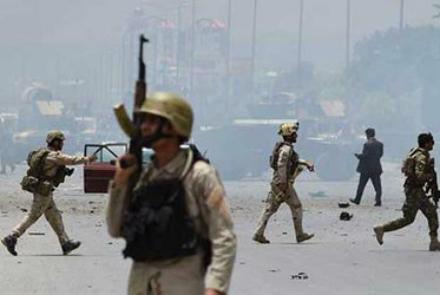In its annual report for 2017 on civilian casualties in Afghanistan, the United Nations Assistance Mission in Afghanistan (UNAMA) said Thursday that Afghan civilians continue to bear the brunt of Afghanistan’s ongoing conflict with over 10,000 casualties reported during 2017.
Based on the report, a total of 10,453 civilian casualties - 3,438 people killed and 7,015 wounded - were documented in the 2017 Annual Report released jointly by (UNAMA) and the UN Human Rights Office.
Referring to the report, Tadamichi Yamamoto, the Secretary-General’s Special Representative for Afghanistan said that the statistics in the report provides credible data about the implication of the devastating war on the Afghan people.
“The chilling statistics in this report provide credible data about the war’s impact, but the figures alone cannot capture the appalling human suffering inflicted on ordinary people, especially women and children,” said Yamamoto.
He also expressed deep concern at the increased harm to civilians caused by suicide attacks. “I am particularly appalled by the continued indiscriminate and unlawful use of IEDs such as suicide bombs and pressure-plate devices in civilian populated areas. This is shameful,” he said.
The report notes that ground engagement between anti and pro-government elements during 2017 shows a 19 percent decrease from the record levels in 2016.
The report attributes close to two-thirds of all casualties (65 percent) to anti-government elements: 42 percent to the Taliban, 10 percent to Daesh and 13 percent to undetermined and other anti-government elements.
“Pro-government forces caused a fifth of civilian casualties: 16 percent were attributed to the Afghan national security forces, two percent to international military forces, one percent each to pro-government armed groups and undetermined pro-government forces. Unattributed cross-fire during ground engagements between anti-government elements and pro-government forces caused 11 percent of civilian casualties,” an excerpt from the report states.
According to the report women and children remained heavily affected by conflict-related violence.
UNAMA documented that, in 2017, 359 women were killed - a rise of five percent - and 865 injured. Child casualties - 861 killed and 2,318 injured - decreased by 10 percent compared with 2016.
According to the report, Attacks where anti-government elements deliberately targeted civilians accounted for 27 percent of the total civilian casualties recorded in Afghanistan in 2017 - mainly from suicide and complex attacks directed at civilians or civilian objects.
The deadliest single incident documented since UNAMA began recording civilian casualties in 2009 occurred in Kabul on 31 May last year when a suicide bomber detonated a truck laden with approximately 2,000 kgs of military grade explosives during the morning rush hour in a densely populated area. This massive blast killed 92 civilians and injured 491.
Afghans are not safe anywhere
UN High Commissioner for Human Rights Zeid Ra’ad Al Hussein has said that today Afghans are not safe anywhere in the country even at mosques or on a bus.
“Afghan civilians have been killed going about their daily lives - travelling on a bus, praying in a mosque, simply walking past a building that was targeted. The people of Afghanistan, year after year, continue to live in insecurity and fear, while those responsible for ending lives and blighting lives escape punishment,” he said.
The report attributes 1,000 civilian casualties (399 deaths and 601 injured) and the abduction of 119 civilians to Daesh. “The group mainly targeted civilians in 2017 but also conducted indiscriminate and disproportionate attacks against security forces in civilian areas,” the report states.
UNAMA recorded 160 deaths and 252 injuries to civilians during six attacks targeting places of worship, religious leaders, and worshippers claimed by Daesh in 2017.
Air strikes
The report states that the number of airstrikes conducted by international military forces and Afghan air forces increased significantly in 2017.
UNAMA documented 631 civilian casualties (295 deaths and 336 injured) from aerial operations conducted by pro-government forces, a seven percent increase from 2016, and the highest number from airstrikes in a single year since 2009. Aerial operations accounted for six percent of all civilian casualties in Afghanistan in 2017.
The report commends actions taken by government and pro-government security forces in 2017 to protect communities from harm, highlighting the 23 percent reduction in civilian casualties attributed to pro-government forces.
Other protection measures adopted by government included a national policy to prevent civilian casualties and ratification of the 1980 Convention on Certain Conventional Weapon instruments, which under Protocol V directs clearance of explosive remnants of war.
The report stresses the importance of implementing Protocol V, noting that in 2017, UNAMA documented 164 deaths and 475 injured as a result of explosive remnants of war.
Eighty-one percent of the victims were children and many of those who survived lost limbs or eyes, and suffered other serious injuries and psychological trauma, limiting their prospects for a normal life.
UNAMA urged parties to the conflict to take action to protect civilians and civilian installations. It calls on anti-government elements to cease the deliberate targeting of civilians and civilian objects and the indiscriminate and disproportionate use of all IEDs.
The UN reports on civilian casualties comes at a time that Afghanistan’s major cities including the nation’s capital Kabul suffered a spate of attacks from the Taliban over the past few weeks leaving almost 150 dead and hundreds more wounded.


